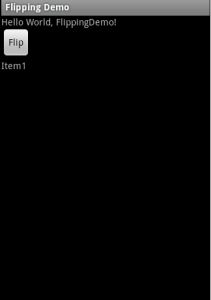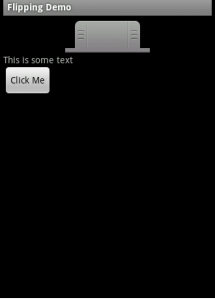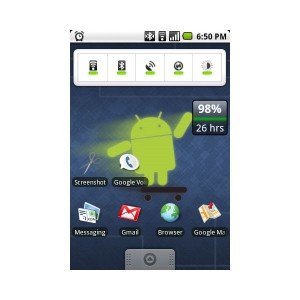Android App Development: View Flipper and Sliding drawer
In this post we’re going to see two interesting controls in Android: ViewFlipper and SlidingDrawer.
View Flipper:
Suppose you want to display a news bar in your activity. this news bar displays a single news item at a time then flips and shows next item and so on, then your choice would be Android’s ViewFlipper.
ViewFlipper inherits from frame layout, so it displays a single view at a time.
consider this layout:
<?xml version="1.0" encoding="utf-8"?>
<LinearLayout xmlns:android="https://schemas.android.com/apk/res/android"
android:orientation="vertical"
android:layout_width="fill_parent"
android:layout_height="fill_parent"
>
<TextView
android:layout_width="fill_parent"
android:layout_height="wrap_content"
android:text="@string/hello"
/>
<Button
android:layout_width="wrap_content"
android:layout_height="wrap_content"
android:text="Flip"
android:id="@+id/btn"
android:onClick="ClickHandler"
/>
<ViewFlipper
android:layout_width="fill_parent"
android:layout_height="fill_parent"
android:id="@+id/flip"
>
<TextView
android:layout_width="fill_parent"
android:layout_height="wrap_content"
android:text="Item1"
/>
<TextView
android:layout_width="fill_parent"
android:layout_height="wrap_content"
android:text="Item2"
/>
<TextView
android:layout_width="fill_parent"
android:layout_height="wrap_content"
android:text="Item3"
/>
</ViewFlipper>
</LinearLayout>
Just a ViewFlipper container that contains three text views:

Now we want to flip the views when the button is clicked
public void onCreate(Bundle savedInstanceState) {
super.onCreate(savedInstanceState);
setContentView(R.layout.main);
btn=(Button)findViewById(R.id.btn);
flip=(ViewFlipper)findViewById(R.id.flip);
}
public void ClickHandler(View v)
{
flip.showNext();
}
If we want to flip in reverese direction we could use flip.showPrevious() instead we can add animations to the child views when they appear or disappear:
@Override
public void onCreate(Bundle savedInstanceState) {
super.onCreate(savedInstanceState);
setContentView(R.layout.main);
btn=(Button)findViewById(R.id.btn);
flip=(ViewFlipper)findViewById(R.id.flip);
//when a view is displayed
flip.setInAnimation(this,android.R.anim.fade_in);
//when a view disappears
flip.setOutAnimation(this, android.R.anim.fade_out);
}
We can also set the ViewFlipper to flip views automatically when the button is clicked:
public void ClickHandler(View v)
{
//specify flipping interval
flip.setFlipInterval(1000);
flip.startFlipping();
}
We can stop the flipping by calling flip.stopFlipping(); method.
Or we can set the flipper to flip autommatically when the activity starts
public void onCreate(Bundle savedInstanceState) {
super.onCreate(savedInstanceState);
setContentView(R.layout.main);
btn=(Button)findViewById(R.id.btn);
flip=(ViewFlipper)findViewById(R.id.flip);
flip.setInAnimation(this,android.R.anim.fade_in);
flip.setOutAnimation(this, android.R.anim.fade_out);
flip.setFlipInterval(1000);
flip.setAutoStart(true);
}
Sliding Drawer:
Remeber Android’s old versions’ (prior to 2.2) launcher screen where we had a sliding pane at the bottom that when dragged upwards displays the applications menu of the phone, that is called the SlidingDrawer control.
<?xml version="1.0" encoding="utf-8"?> <FrameLayout xmlns:android="https://schemas.android.com/apk/res/android" android:layout_width="wrap_content" android:layout_height="wrap_content"> <SlidingDrawer android:layout_width="fill_parent" android:layout_height="fill_parent" android:id="@+id/drawer" android:handle="@+id/handle" android:content="@+id/content" > <ImageView android:layout_width="wrap_content" android:layout_height="wrap_content" android:id="@+id/handle" android:src="@drawable/tray_handle_normal" /> <LinearLayout android:layout_width="fill_parent" android:layout_height="fill_parent" android:orientation="vertical" android:id="@+id/content" > <TextView android:layout_width="wrap_content" android:layout_height="wrap_content" android:text="This is some text" android:id="@+id/txt" /> <Button android:layout_width="wrap_content" android:layout_height="wrap_content" android:text="Click Me" android:id="@+id/btn" android:onClick="ClickHandler" /> </LinearLayout> </SlidingDrawer> </FrameLayout>
When the SlidingDrawer is pressed it looks like this:

The SlidingDrawer is a container that when dragged or pressed shows/hides its contents.
As the SlidingDrawer displays one content at a time, it must be declared within FrameLayout
the SlidingDrawer has two key properties:
android:handle: specifies the id of the control that acts as the handle.
android:content: specifies the id of the view that acts as content of the SlidingDrawer, most times will be a container.
you can open/close the drawer from the code like this:
if(drawer.isOpened())
{
drawer.close();
btnToggle.setText("Open");
}
else
{
drawer.open();
btnToggle.setText("Close");
}
You can open/close the drawer with animation using these methods instead
drawer.animateClose(); drawer.animateOpen();
or you can handle the open/close operations automatically using toggle method:
drawer.toggle(); drawer.animateToggle();
you can lock/unlock the SlidingDrawer to enable/disable dragging or clicking of the drawer using these methods:
drawer.lock(); drawer.unlock();
Responding to SlidingDrawer Events:
SlidingDrawer has three key callbacks:
- When the drawer is open, handled by implementing OnDrawerOpenListener.
- When the drawer is close, handled by implementing OnDrawerCloseListener.
- When the drawer is close, handled by implementing OnDrawerScrollListener.
drawer.setOnDrawerOpenListener(new OnDrawerOpenListener() {
@Override
public void onDrawerOpened() {
// TODO Auto-generated method stub
TextView txtStatus=(TextView)findViewById(R.id.txtStatus);
txtStatus.setText("Opened");
ImageView view=(ImageView)drawer.getHandle();
view.setImageResource(R.drawable.tray_handle_selected);
}
});
drawer.setOnDrawerCloseListener(new OnDrawerCloseListener() {
@Override
public void onDrawerClosed() {
// TODO Auto-generated method stub
TextView txtStatus=(TextView)findViewById(R.id.txtStatus);
txtStatus.setText("Closed");
ImageView view=(ImageView)drawer.getHandle();
view.setImageResource(R.drawable.tray_handle_normal);
}
});
drawer.setOnDrawerScrollListener(new OnDrawerScrollListener() {
@Override
public void onScrollStarted() {
// TODO Auto-generated method stub
TextView txtStatus=(TextView)findViewById(R.id.txtStatus);
txtStatus.setText("Scroll start");
}
@Override
public void onScrollEnded() {
// TODO Auto-generated method stub
TextView txtStatus=(TextView)findViewById(R.id.txtStatus);
txtStatus.setText("Scroll end");
}
});
You can make the drawer appear horizontally from right to left by setting the android:orientation property to horizontal in the xml file.
That was the View Flipper and Sliding drawer controls, stay tuned for another tutorial next week






 android
android 